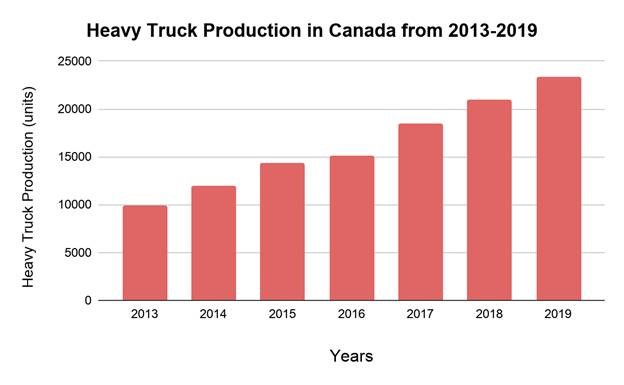Canada has more than a million kilometers of (two-lane equivalent) roads of which make up the National Highway System (NHS). Road transportation is the most important mode for passenger and freight transportation, local (intra-city) and intercity transportation, intra-provincial transportation activities, and trade between Canada and the United States.
Canada has 17,000 km (11,000 mi) of expressways, which makes Canada the third-longest collection in the world behind the United States and China.
Canada’s road network is shared by a wealth of different users, including 20 million light vehicles, 750,000 medium and heavy trucks, 15,000 public transit buses.
In the mid-2000s, cars and trucks each made up around 50% of new personal vehicle sales. In 2017, around 70% of newly registered vehicles in Canada were trucks.
These vehicles traveled a total of 333.29 billion kilometers, of which 303.6 billion was for vehicles under 4.5 tones, 8.3 billion was for vehicles between 4.5 and 15 tones and 21.4 billion was for vehicles over 15 tones. For the 4.5- to 15-tonne trucks, 88.9% of vehicle-kilometers were intra-province trips, 4.9% were inter-province, 2.8% were between Canada and the US, and 3.4% made outside of Canada. For the trucks over 15 tones, 59.1% of vehicle-kilometers were intra-province trips, 20% inter-province trips, 13.8% Canada-US trips, and 7.1% trips made outside of Canada.
The Canadian Trucking Alliance reports says that in Canada alone, the trucking industry is worth over $65 billion with more than 260,000 drivers and over 400,000 employees overall. The nation’s freight system is a partnership between public and private sectors, with each sector providing substantial parts of the physical infrastructure for these movements.
Canada’s economic strength relies heavily on an efficient, safe, secure and sustainable freight transportation system. Whether it’s moving a load from one end of Canada to the other or cross-border trucking from Canada into the US, the system must provide for the flexible, reliable and economic movement of goods.
North American Truck stops along the highway were too busy as the trucking industry was booming up until last year. Many trucks crossed the border on a daily basis until the end of 2019.
Beginning of the 2020 things start to change because of Coid-19 and so far the 1st quarter is an economic disaster for so many small businesses including the trucking industry.
The Transport & trucking industry was thriving & this diverse industry is made up of a few large companies and thousands of small and medium-sized businesses around the US and Canada.
The Canadian Trucking Alliance reports that in Canada alone, the trucking industry is worth over $65 billion with more than 260,000 drivers and over 400,000 employees overall.
The nation’s freight system is a partnership between public and private sectors, with each sector providing substantial parts of the physical infrastructure for these movements. According to Freight Facts and Figures, the largest of these movements continue to be the trucking industry, which is responsible for moving 60.1 percent of volume and 69.5 percent of value around the globe.
In 2012, statistics showed that 90 percent of all consumer products and foodstuffs were shipped by truck throughout Canada, and almost two-thirds (by value) by trade with the US, which remains Canada’s largest trading partner. Without the trucking industry, the wheels of commerce would stop rolling.
As a whole, the trucking industry generates more than $67 billion in revenues each year between private carriers, courier firms, for-hire carriers, and owner-operators. Trucking firms or freight carriers accounted for 57 percent of the for-hire revenues of the industry. Heavy truck freight carriers accounted for 21.8 billion vehicle-kilometers, while medium-sized trucks accounted for 7.4 billion kilometers.
Trucking is a key trade facilitator between Canada and the United States. Approximately two-thirds of Canada-US trade is moved by truck, including more than 80 percent of all US exports to Canada. Canadian for-hire trucking firms are responsible for just over 80 percent of the total tonnage shipped intra-provincially.
Truckload transportation adds to the national economy by providing jobs for millions of people. While the number of jobs in the trucking industry continues to rise, the key to keeping this interconnected network in balance is ensuring the capacity for growth and reliability of services.
Now at the end of the first quarter of 2020 where are we standing? Are we ready to accept the challenges that will arise in this industry because of this pandemic?
Have we set up any plan to deal with this financial disaster?
What will happen if this pandemic will stay any longer ?
How will we handle the financial fall down after this period ?
Will it be easy to handle after affect ?
I will find the answer to these questions in my next blog…………………….

